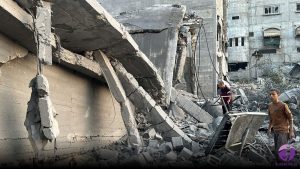The town of Rodynske is enveloped in a pungent odor that lingers in the air. Just a few minutes after entering the city, we identify the source of the commotion.
A 250kg glide bomb has struck the town’s main administrative building, destroying three residential blocks. Our visit comes just a day after the bomb detonated, yet remnants of the destruction continue to emit smoke. In the outskirts of the town, the echoes of artillery fire and gunshots resonate as Ukrainian soldiers engage in the critical task of shooting down drones.
Located approximately 15 kilometers (9 miles) to the north of the conflict-ridden city of Pokrovsk, Rodynske is a notable point in the region. Since the autumn of the previous year, Russia has made attempts to seize control from the south, yet Ukrainian forces have successfully thwarted Russian troops’ advance.
Russia has shifted its strategy, now focussing on encircling the city and severing supply routes.
In recent weeks, as frantic diplomatic initiatives aimed at achieving a ceasefire in Ukraine have faltered, Russia has escalated its military operations, marking its most substantial territorial gains since January.
Evidence of this can be observed in Rodynske.
Shortly after we arrive in town, the sound of a Russian drone can be heard overhead. The team swiftly moves towards the nearest available cover: a tree.
We huddle close to the surface, ensuring the drone remains oblivious to our presence. A sudden explosion reverberates through the air as a second drone strikes nearby. A drone continues to hover above us. For several more minutes, the chilling whir of what has emerged as the most lethal weapon of this conflict fills the air.
As the sound fades into silence, we seize the opportunity to dash toward the safety of an abandoned building located just 100 feet away.
The drone’s sound resonates once more from the shelter. It could be returned after observing our activity.
The swarm of Russian drones targeting Rodynske suggests that the source of these attacks is likely from positions significantly closer than the established Russian locations to the south of Pokrovsk. Reports indicate that the movement is expected to originate from recently seized territory along a crucial route connecting the eastern region of Pokrovsk to Kostyantynivka.
Following a tense half-hour wait in the shelter, as the sound of the drone fades into silence, we swiftly make our way to our vehicle, which is parked beneath the protective canopy of trees, and accelerate out of Rodynske. Alongside the highway, smoke rises ominously, indicating that something is ablaze – it appears to be a downed drone.
The journey takes us to Bilytske, a location situated further from the frontline. A row of houses lay in ruins following an overnight missile strike. Among the locations was Svitlana’s residence.
The situation continues to deteriorate. In the distance, the sound of explosions echoed, indicating they were occurring far away. ” Our town is now under attack—we are feeling it firsthand,” states the 61-year-old as she gathers a few possessions from the debris of her house. Fortunately, Svitlana was not present at her residence during the attack.
Visit the heart of the town, where the extent of the destruction is strikingly evident. ” The bakery and zoo have also been destroyed,” she states.
We encounter members of the artillery unit from the 5th Assault Brigade in a secure location beyond the surveillance of drones.
The intensity of Russian assaults is on the rise, creating a palpable sense of urgency in the region. ” Rockets, mortars, drones—they’re deploying all available resources to sever supply routes leading into the city,” Serhii states.
For three days, his unit has remained on standby, poised to deploy to their designated positions as they await the arrival of cloud cover or high-speed winds, which would provide essential protection from drone surveillance.
In a conflict that continues to evolve, military personnel are compelled to swiftly adjust to emerging threats brought about by technological advancements. he most recent danger has emerged from fiber optic drones. drone is equipped with a spool containing tens of kilometers of cable, with a physical fiber-optic cord connected to the controller operated by the pilot.
The transmission of video and control signals to and from the drone occurs via a cable rather than utilizing radio frequencies. “Th is means electronic interceptors can’t jam, states a soldier known by the call sign Moderator, who serves as a drone engineer with the 68th Jaeger Brigade.
As the conflict escalated, the deployment of drones became a significant factor, prompting both militaries to equip their vehicles with advanced electronic warfare systems designed to counteract these unmanned aerial threats. e protective measures previously in place have diminished with the introduction of fiber optic drones, giving Russia a significant advantage in the deployment of these advanced technologies. raine is making efforts to increase its production capabilities.
Russia began deploying fiber optic drones significantly earlier than we did, as we were still in the testing phase. T se drones’ capabilities extend to environments that require operation at lower altitudes than standard models allow. “We can ev en enter houses and search for targets inside,” states Venia, a drone pilot affiliated with the 68th Jaeger Brigade.
“We’ve begun to joke that perhaps we should bring scissors to cut the cord,” remarks Serhii, the artilleryman.
While fibre optic drones offer unique capabilities, they are not without limitations. Their sp ed is a notable concern, and there is the potential risk of the cable becoming entangled in trees. Current , Russia’s extensive deployment of these vehicles has resulted in the transportation of soldiers to and from their positions becoming potentially more lethal than the combat zones themselves.
Upon entering a position, uncertainty looms regarding whether one has been detected. “If you ha ve been spotted, you may already be living the final hours of your life,” warns Oles, Chief Sergeant of the reconnaissance unit of the 5th Assault Brigade.
The ongoing threat is resulting in soldiers extending their time in their current positions.
Oles and his unit are positioned in the infantry, actively engaged in the trenches at the forefront of Ukraine’s defense efforts. In toda s landscape, it is increasingly uncommon for reporters to engage directly with foot soldiers, given the heightened dangers associated with accessing these frontline trenches. In a ru l home repurposed as a makeshift base, we encounter Oles and Maksym, soldiers who take refuge here during their downtime between deployments.
During my time in the position, I was there for a maximum of 31 days. However, I am aware of individuals who have remained for as long as 90 and even 120 days. “Before th e arrival of drones, rotations at the position could have ranged from 3 to 7 days,” states Maksym.
“War embodies bloodshed, mortality, the mire of mud, and an all-encompassing chill that seeps from head to toe.” This is the way you allocate your time each day. There w a particular occasion when we remained awake for three consecutive days, fully alert every single minute. The Rus ans continued their relentless assault, advancing upon us in wave after wave. “A slight misstep could have resulted in our demise.”
Oles reports that Russia’s infantry has altered its tactical approach. Previou y, they launched assaults in coordinated groups. Current , they dispatch only one or two individuals at a time. Motorcy es are utilized, along with quad bikes, in certain instances. At time they manage to evade capture.
The current situation on the front lines has evolved beyond traditional boundaries, with Ukrainian and Russian forces no longer occupying distinct sides. Instead, the conflict resembles a dynamic chess game, where positions are fluid and intermingled, reflecting a complex and shifting battlefield landscape.
This complicates the visibility of progress achieved by both parties.
While Russia has made recent advancements, the complete takeover of the Donetsk region, which includes Pokrovsk, is unlikely to be swift or straightforward.
Ukraine has mounted a vigorous defense, yet it requires a consistent influx of weapons and ammunition to maintain its efforts in the ongoing conflict.
As the conflict extends into its fourth summer, the challenges facing Ukraine in terms of workforce against a significantly larger Russian military are becoming increasingly apparent—the maj ity of soldiers enlisted in the army following the onset of the war. Despite everal months of training, they have been compelled to acquire a significant amount of knowledge on the job amid the chaos of an ongoing battle.
Maksym was employed by a beverage company before enlisting in the military. I enqui d about how his family manages the challenges posed by his profession.
It presents significant challenges, indeed. My fami provides me with firm support. However I have a two-year-old son, and my opportunities to see him are limited. “I do vide o call him, so everything is as fine as it could be under the circumstances,” he says, his voice faltering as tears begin to well in his eyes.
Maksym serves as a soldier in defense of his country, yet he is also a father longing for his two-year-old son.













